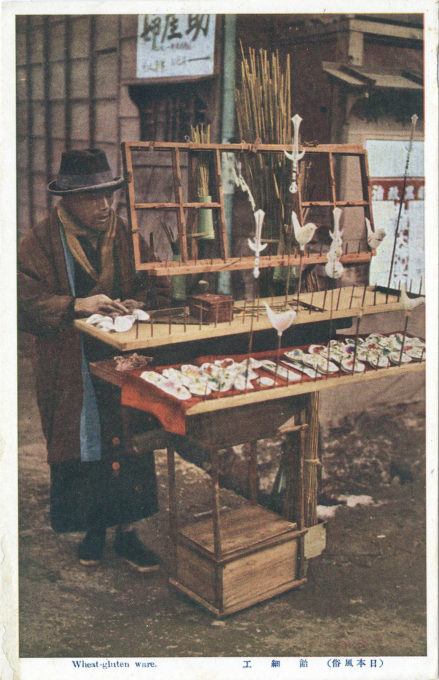
Amezaiku [sugar sculpture; 飴細工, lit. slender candy worker] street vendor, c. 1930. Amezaiku are created using mizuame, a sugar syrup made from rice or potato starch, similar to corn syrup. The candy base is prepared beforehand, kneaded and formed into a large ball. At the stall, the artist reheats it to make the mizuame pliable for sculpting. Some amezaiku artists are also street performers who perform magic tricks and tell stories along with their candy crafting entertainment.
See also:
Royal Dutch Chocolate Cocoa advertising postcard, c. 1920.
“Amezaiku is Japanese candy craft artistry.
“An artist takes multi-colored mizuame [a clear, thick, sticky liquid most often made from glutinous rice or sweet potato starch] and, using their hands and other tools such as tweezers and scissors, creates a sculpture. Amezaiku artists also paint their sculpted candy with edible dyes to give the finished work more character. Animals and insects are common amezaiku shapes created to appeal to children. Some amezaiku artists are also street performers who perform magic tricks and tell stories along with their candy craft entertainment.
“During the Heian period, the art of amezaiku was used in Japan for candy offerings made at temples in Kyoto. The amezaiku craft spread beyond the temple during the Edo period, when many forms of street performance flourished in Japan and when its base ingredient, mizuame, became widely available. During the Edo period, it emerged in its present artistic form.
“The candy base is prepared beforehand, using a starchy syrup recipe that requires careful monitoring to ensure proper consistency and appearance. The mixture is kneaded and pulled by hand, and formed into a large ball to be stored until ready to use. At the stall, the candy ball is heated to make it pliable again. The artist puts their hand into the hot mass to pinch up the material necessary; this too is a skill, as the artist must learn to tolerate the painful heat of the medium.
“The hot candy is quickly rolled and mounted on a stick, then pulled, twisted and clipped into form, usually an animal of some kind and often intricate. Speed is necessary to the art since the sculpture must be completed before the candy cools and hardens again.”
– Wikipedia


Pingback: “Charcoal dealer”, Japan, c. 1920. | Old TokyoOld Tokyo